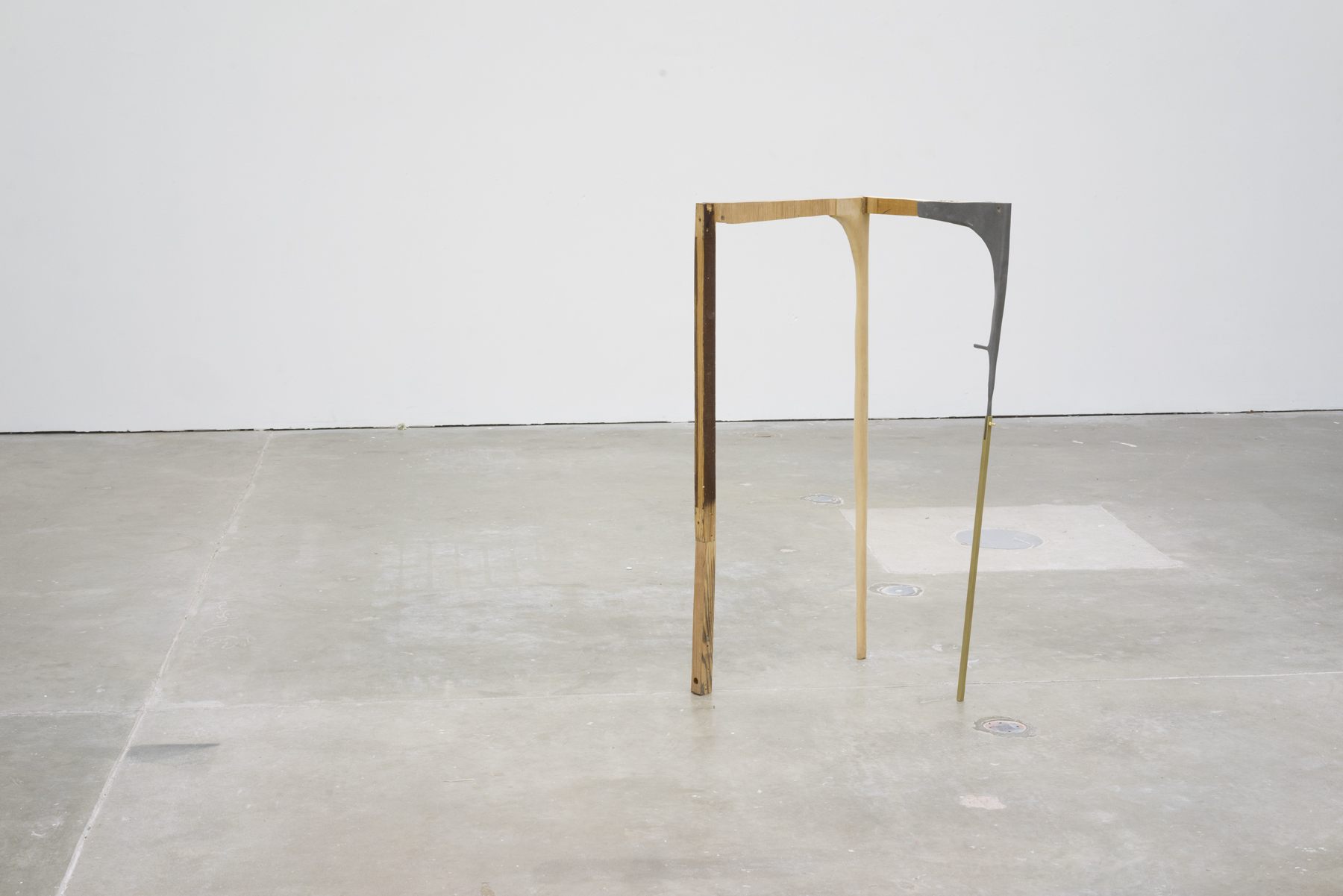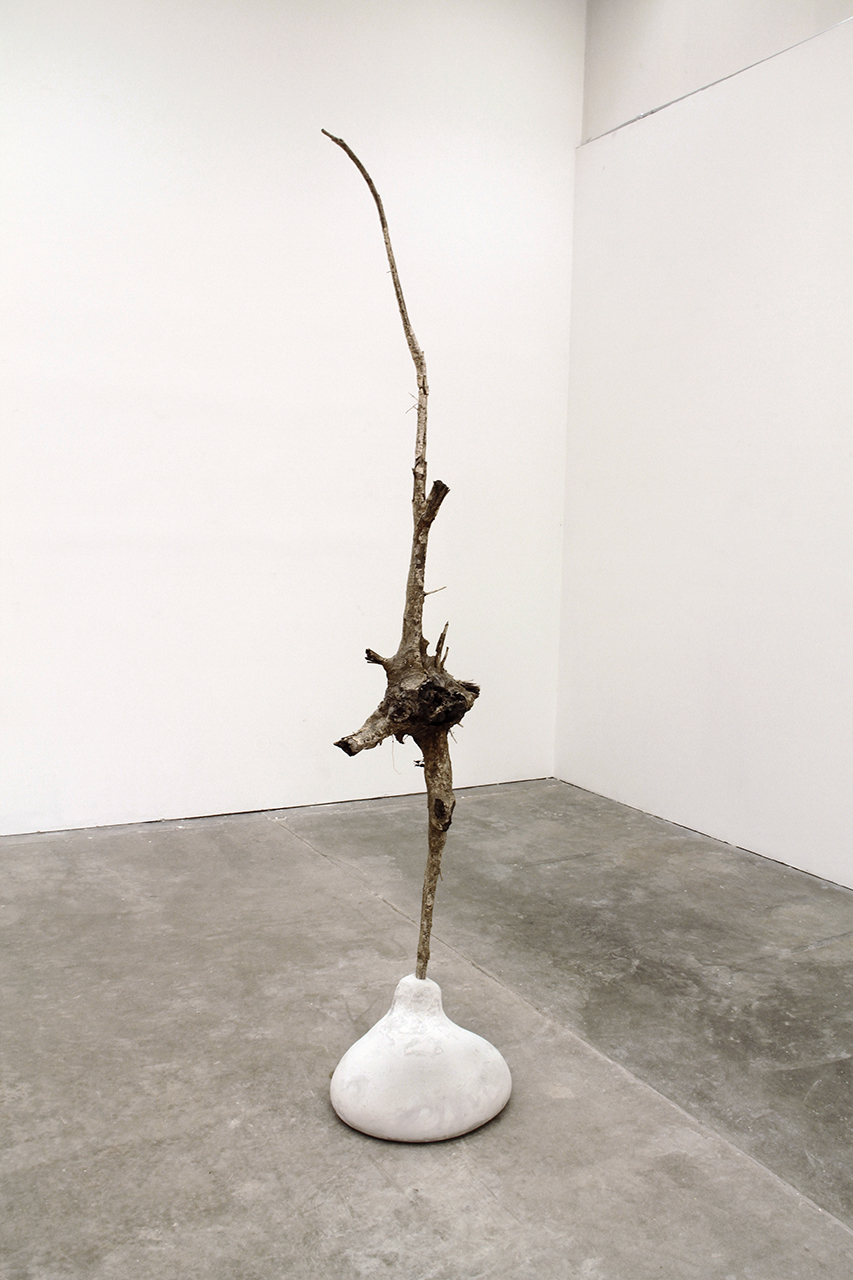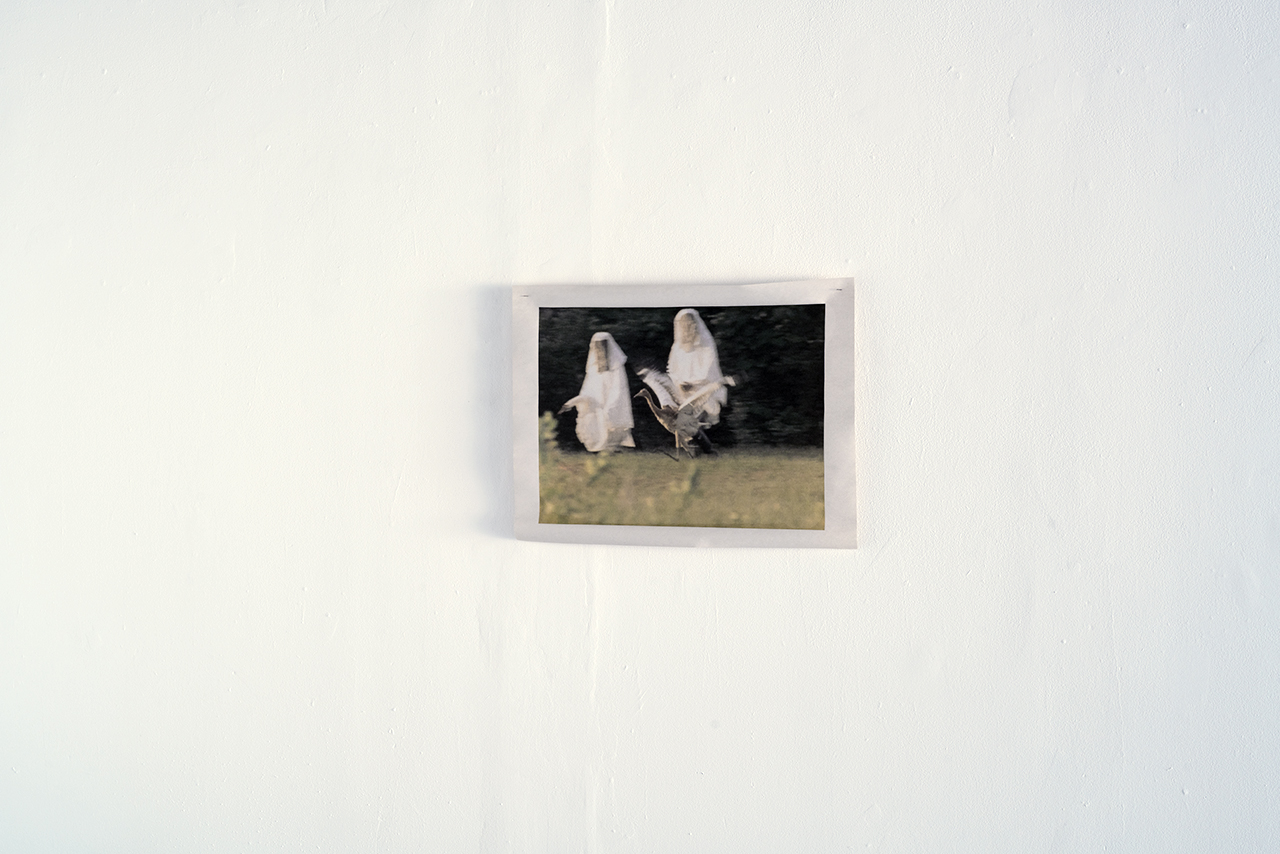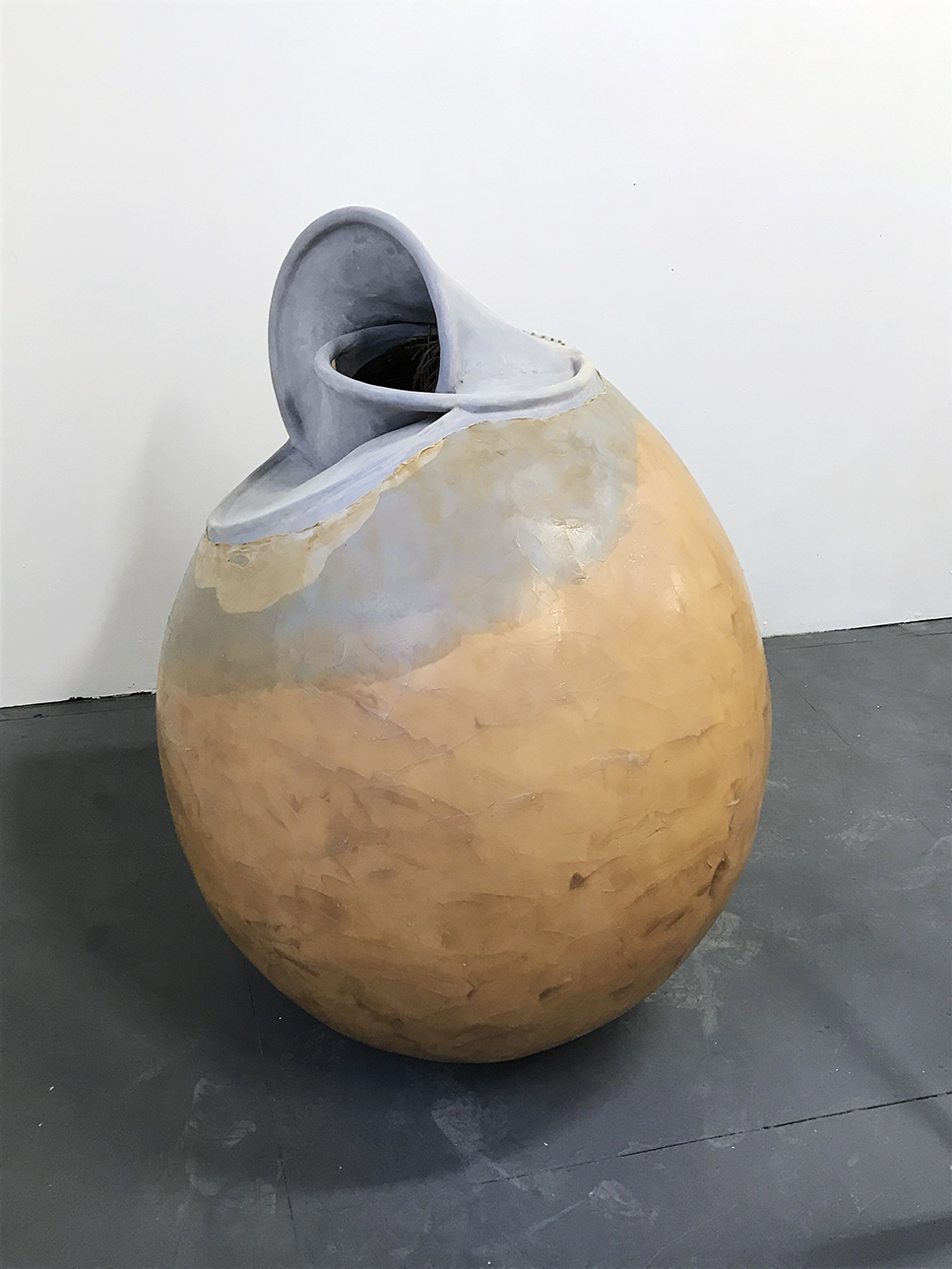Work samples
About Anne Clare
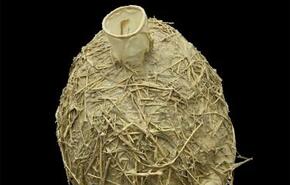
Sculptures 01
I make work that privileges the tacit, the inarticulate, or the meanings which can exists before language. Meaning is made through shared tools like language, but I also want to consider the ways that these tools can blind us to other possibilities of knowing.
My sculptures are anchored in the real world in the same way that a mushroom anchors itself to a dead tree— reliant on it for nourishment, while, at the same time, breaking down the structure that supports its place in the world. My sculptures, in this sense, take their purpose from the model of digestion, nourishment, and assimilation.
Odd as it may sound, I find an analogy between my work and mushrooms. Consider the common names used for the following fungi: dead man's fingers (Xylaria Polymorpha), Hairy Earth Tong (Trichoglossum hirstum), and Black Witche's Butter (Exidia Glandulosa), to name a few. When paging through a field guide to mushrooms and reading these names, I am reminded of Joseph Campbel who, in reference to lirugy described Latin as, "A language that throws you out of your domesticity". I think we should consider Campbell's words in the context of scupture as well. Sculpture—my sculpture—is a language that throws you out of your domesticity.
-
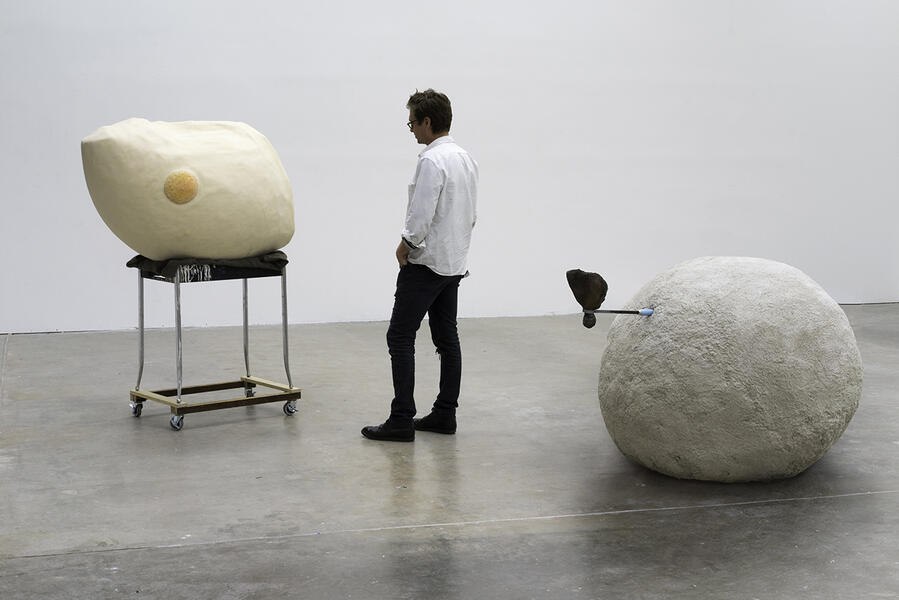 Installation viewLeft: Mass on Table on Dolly, Hydrocal, cast foam, paper, found table, blanket, pine, casters 52 x 31 x 65 in Right: I still love you, dead mushroom, steel, pine, paper pulp, hydrocal, 44 x 54 x 55 in.
Installation viewLeft: Mass on Table on Dolly, Hydrocal, cast foam, paper, found table, blanket, pine, casters 52 x 31 x 65 in Right: I still love you, dead mushroom, steel, pine, paper pulp, hydrocal, 44 x 54 x 55 in. -
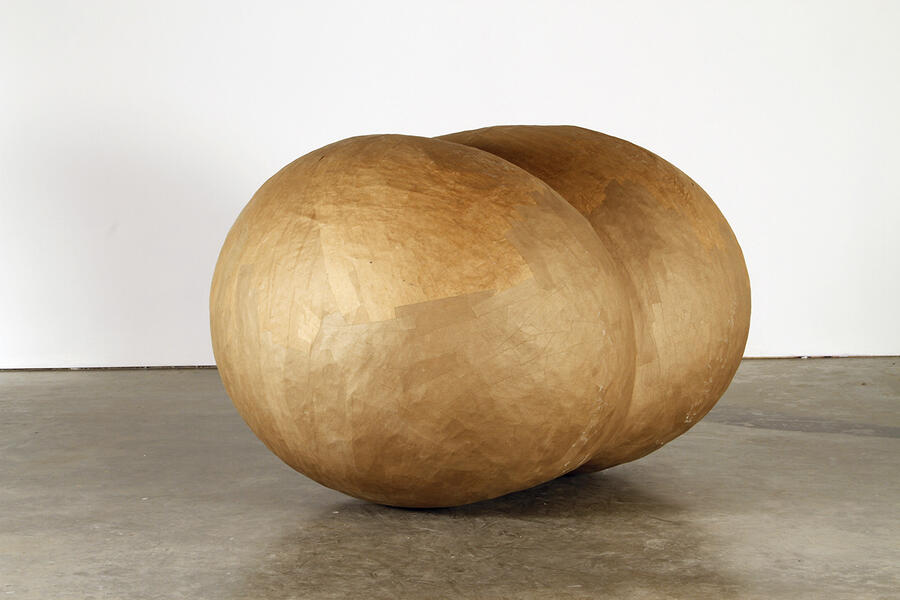 VesselVessel, Paper, glue, 37 x 74 x 44 in.
VesselVessel, Paper, glue, 37 x 74 x 44 in. -
 Tube (I lost)Found aluminum foil, driftwood, steel, chair leg, Herman Miller base, 27 x 24 x 67 in. This sculpture was inspired by hospital furniture and a tube of aluminum foil I found in a creek. Having weathered the elements, the aluminum foil was transformd, it was beautiful. I built an armature to house the mysterious tube in an upright position. I incorporated casters into this piece (amongst others) to emphasize that nothing is static.
Tube (I lost)Found aluminum foil, driftwood, steel, chair leg, Herman Miller base, 27 x 24 x 67 in. This sculpture was inspired by hospital furniture and a tube of aluminum foil I found in a creek. Having weathered the elements, the aluminum foil was transformd, it was beautiful. I built an armature to house the mysterious tube in an upright position. I incorporated casters into this piece (amongst others) to emphasize that nothing is static. -
 Tube (I lost) (datail)Detail of Tube (I lost) Found aluminum foil, driftwood, steel, chair leg, Herman Miller base, 27 x 24 x 67 in.
Tube (I lost) (datail)Detail of Tube (I lost) Found aluminum foil, driftwood, steel, chair leg, Herman Miller base, 27 x 24 x 67 in. -
 SpineCast hay and latex, steel, 83 x 13 x 11 in. I was interested in pushing the material potential hay whilst also creating a visual expression of digestion.
SpineCast hay and latex, steel, 83 x 13 x 11 in. I was interested in pushing the material potential hay whilst also creating a visual expression of digestion. -
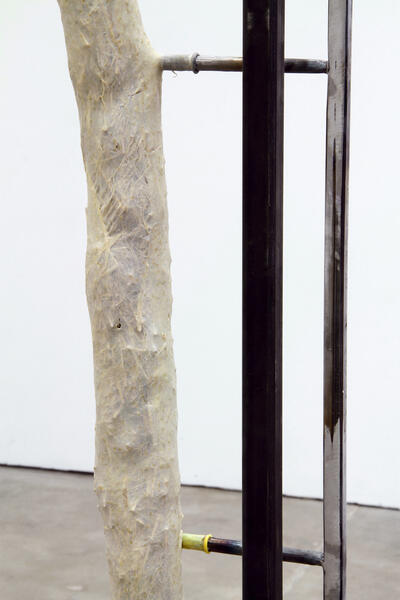 Spine (detail_cast latex and hay, steel, 83 x 13 x 11 in. Ballon lips function as the point of connection between the cast form and the armature, a motif in several of my works. I use this to give the impression of intimacy, that the point of connection is somthing that could be kissed or filled with air from a persons lungs.
Spine (detail_cast latex and hay, steel, 83 x 13 x 11 in. Ballon lips function as the point of connection between the cast form and the armature, a motif in several of my works. I use this to give the impression of intimacy, that the point of connection is somthing that could be kissed or filled with air from a persons lungs. -
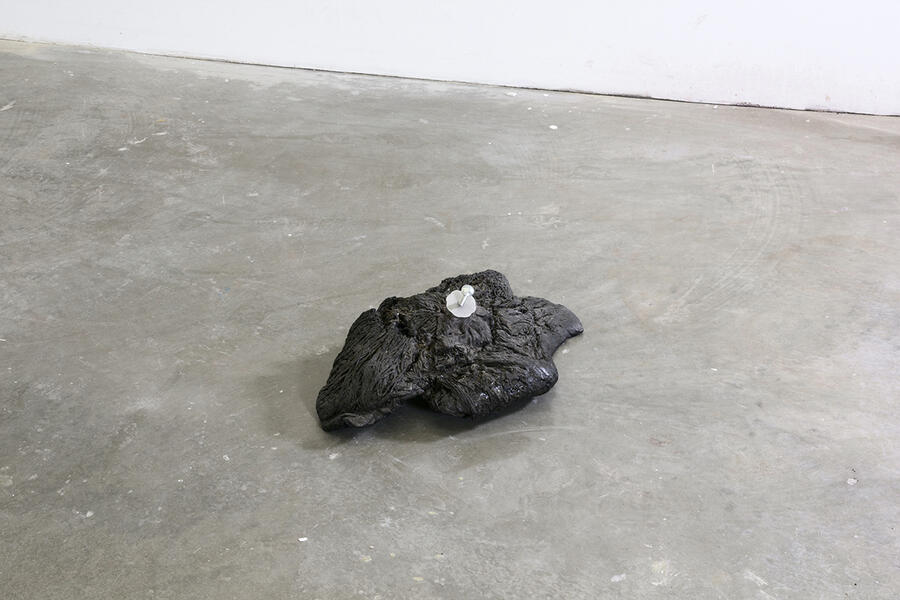 Part of the treerope, asphalt, steel hardware, deminsions vary, approx. 14 x 25 x 11in. This asphalt and fiber structure is maliable, though it's movment is slow. This sculpture slowly adapts to its surounding environment, and thus, its form continualy changes. In this piece, I was interested in conveying somthing beyond what is visually perceptable; in this case motion but akin to the speed of a growing plant.
Part of the treerope, asphalt, steel hardware, deminsions vary, approx. 14 x 25 x 11in. This asphalt and fiber structure is maliable, though it's movment is slow. This sculpture slowly adapts to its surounding environment, and thus, its form continualy changes. In this piece, I was interested in conveying somthing beyond what is visually perceptable; in this case motion but akin to the speed of a growing plant. -
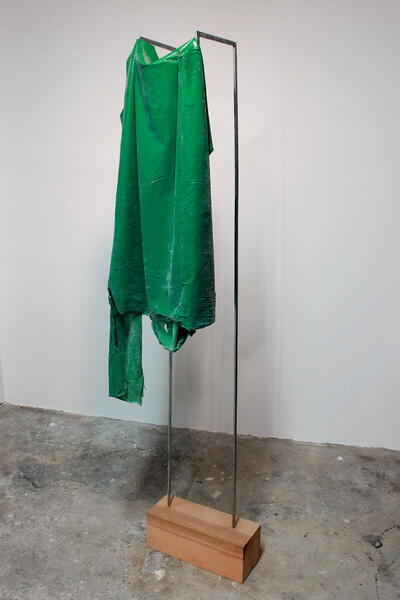 SleeveLatex, steel, cedar, 17 x 6 x 70 in. The green form is a latex cast that was molded from a failed sculpture. The cast hangs from a steel armautue and, like cloths hanging out to dry, flutters with the movment of air.
SleeveLatex, steel, cedar, 17 x 6 x 70 in. The green form is a latex cast that was molded from a failed sculpture. The cast hangs from a steel armautue and, like cloths hanging out to dry, flutters with the movment of air. -
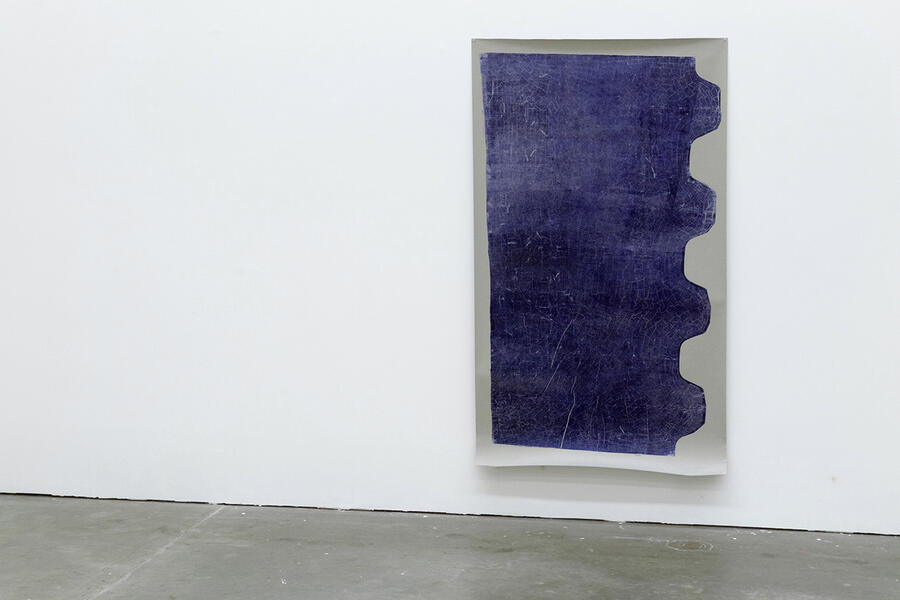 Impression no. 3Collagraph; litho ink on paper, 40 x 78 in.
Impression no. 3Collagraph; litho ink on paper, 40 x 78 in. -
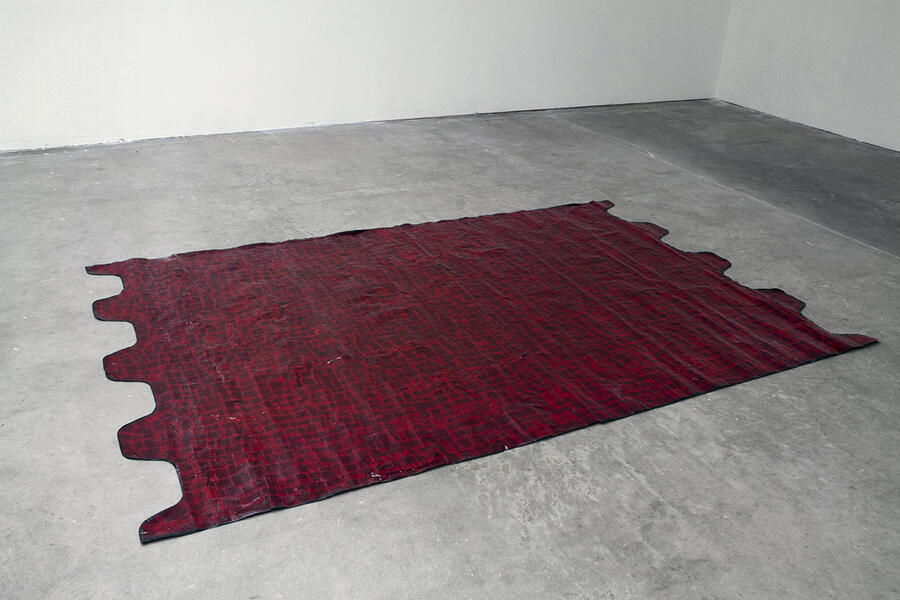 RugAcrylic tape, garbage bags, 60 x 96 in.
RugAcrylic tape, garbage bags, 60 x 96 in.
Sculptures 02
-
 Three legsbrass, steel, pine, wood glue 22 x 19 x 48 in.
Three legsbrass, steel, pine, wood glue 22 x 19 x 48 in. -
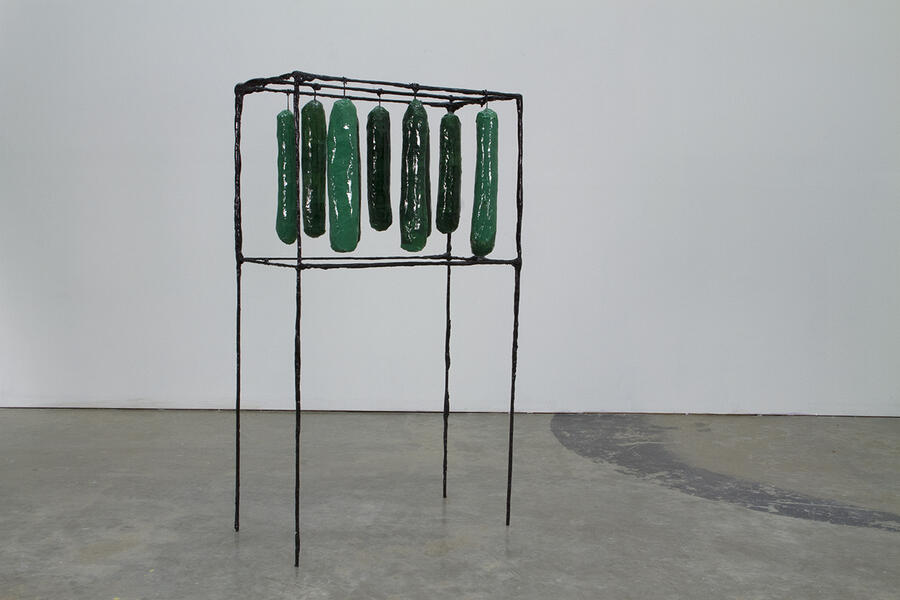 IncubatorSteel, asphultum, twine, paper, glue, epoxy 31 x 16 x 50 in.
IncubatorSteel, asphultum, twine, paper, glue, epoxy 31 x 16 x 50 in. -
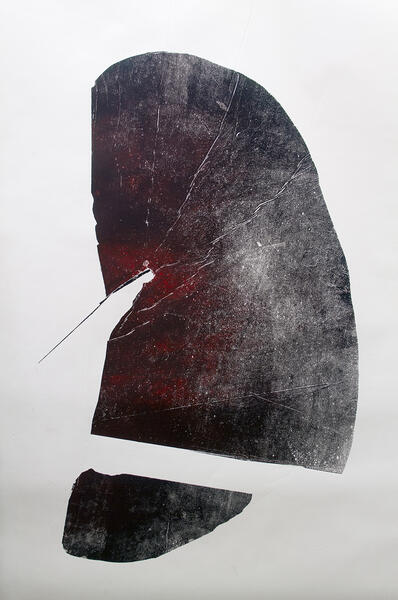 Impression no. 4Collagraph; litho ink on paper, 52 x 64 in.
Impression no. 4Collagraph; litho ink on paper, 52 x 64 in. -
 PunctureDriftwood, cement, 17 x 16 x 114 in.
PunctureDriftwood, cement, 17 x 16 x 114 in. -
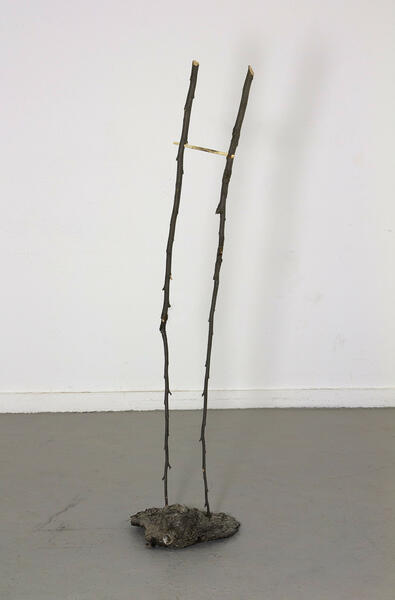 SpecterMop head, asphalt, found wood, poplar 15 x 14 x 61 in.
SpecterMop head, asphalt, found wood, poplar 15 x 14 x 61 in. -
 NocturnInkjet print, 21 x 35 in.
NocturnInkjet print, 21 x 35 in. -
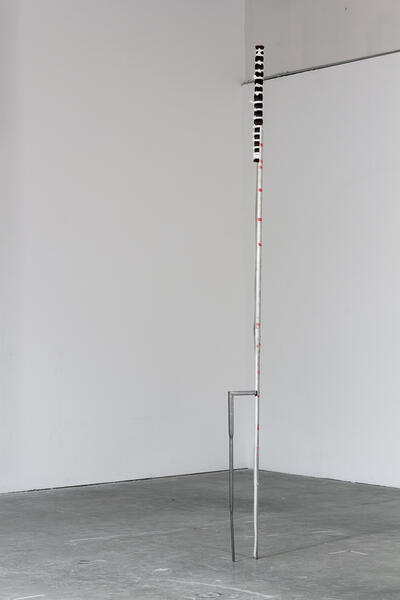 First PositionHorse hair bundle, aluminum, steel, 9 x 2 x 125 in. Horse hair is pressure fit to bisected aluminum tube.
First PositionHorse hair bundle, aluminum, steel, 9 x 2 x 125 in. Horse hair is pressure fit to bisected aluminum tube. -
 That dark cottagepigment print on paper, 18 x 24 in.
That dark cottagepigment print on paper, 18 x 24 in. -
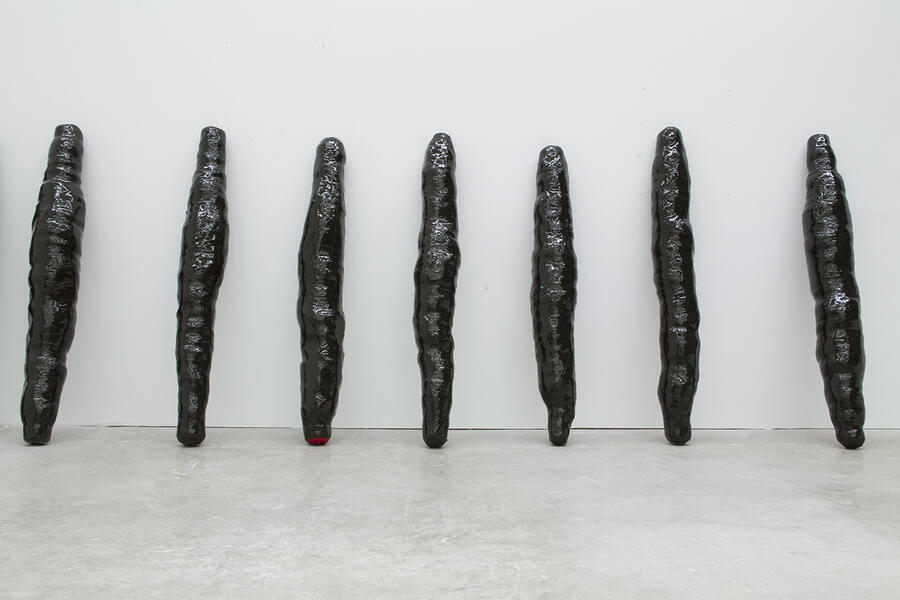 Caryatids (wrapped)Caryatids (wrapped) Acrylic tape, foam approx. 12 x 12 x 65 in. per form
Caryatids (wrapped)Caryatids (wrapped) Acrylic tape, foam approx. 12 x 12 x 65 in. per form -
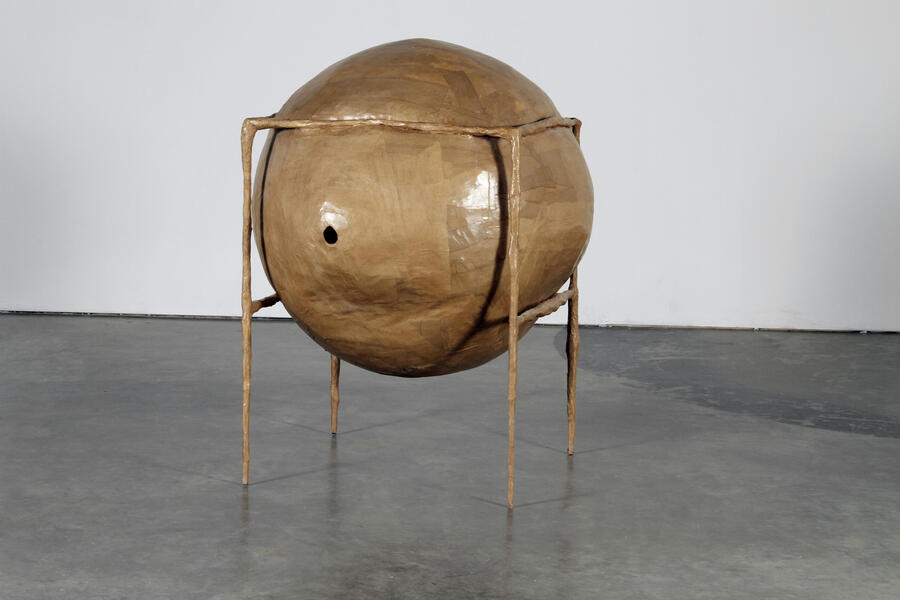 Stomachpaper mâché, polycrylic, steel,
Stomachpaper mâché, polycrylic, steel,
A Potato in Space
Some of Saturn’s lesser moons (which do, in fact, resemble the root vegetable) have been
dubbed “potatoids.” These non-spherical, lumpy satellites are held in their orbit by the
balance of centrifugal force and gravity. This is the structure of their relationship to their
parent planet. There are not, of course, potatoes in space, though I like the thought.
Naming an object draws it closer, makes it knowable (or at least, makes it possible for us to
think we know it). Naming allows us to bridge a gap, though the act of naming also carries
the risk that we will simplify, limit, or reduce what we are trying to understand. At the same
time that we call a small moon a potatoid, we drift further from knowing the reality of the
satellite, its true character.
My work is concerned with meaning-making, time, loss, and death. Calling these satellites
potatoids is itself a metaphor for our attempt to accommodate the unknowable, a comically
familiar name for something far, far from our grasp. Grief is a similar search for the right
name; it lies between the desire for the thing lost and the devastating fact that it is gone.
It is in this space—between the wish and the fact—that I seek to locate my work.
-
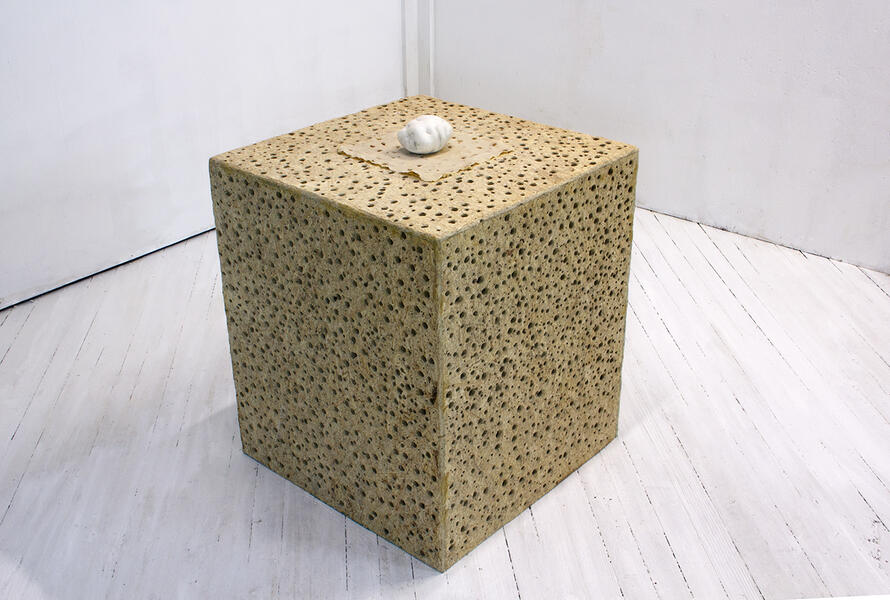 Marble potato
Marble potatoCarrara white marble, particle board, latex
24 x 24 x 30 in.
-
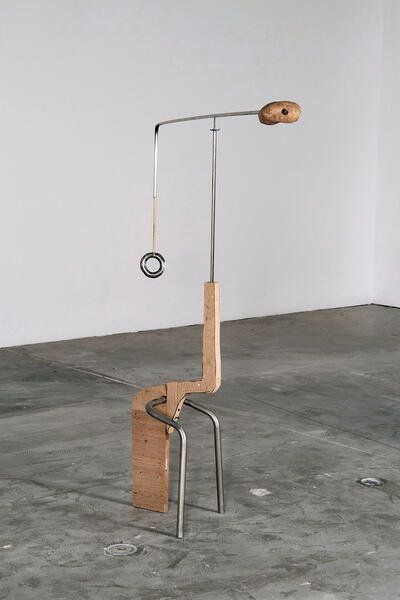 Love PoemPotatoes, inflated steel, brass, pine, chair leg, hardware, 70 x 13 x 63 in. This is a mobile. The donut-shaped inflated steel is balanced to the weight of potatoes. As the potatoes decay, the balance of the mobile shifts. This piece was made in response to the death of a loved one. Through the metaphore of a root vegitable I sought to give motion to and make verticle something from the gound.
Love PoemPotatoes, inflated steel, brass, pine, chair leg, hardware, 70 x 13 x 63 in. This is a mobile. The donut-shaped inflated steel is balanced to the weight of potatoes. As the potatoes decay, the balance of the mobile shifts. This piece was made in response to the death of a loved one. Through the metaphore of a root vegitable I sought to give motion to and make verticle something from the gound. -
 Weather vaneWeather vane: poplar, paper mache, human hair 51 x 28 x 34 in. This sculpture comprises thousands of strands of the artist's hair, which were embedded into the leg-like form through a process of making pore sized punctures into the paper surface, dipping individual hairs into Elmers glue and plugging the holes.
Weather vaneWeather vane: poplar, paper mache, human hair 51 x 28 x 34 in. This sculpture comprises thousands of strands of the artist's hair, which were embedded into the leg-like form through a process of making pore sized punctures into the paper surface, dipping individual hairs into Elmers glue and plugging the holes. -
 Weather vane (detail)Human hair, poplar, paper, glue
Weather vane (detail)Human hair, poplar, paper, glue -
 Mirror ShapedMirror Shaped: Broom stick, pex tubing, found vine, 81 x 38 x 2 in. Curve of pex tubing is maintained though the tension of vine.
Mirror ShapedMirror Shaped: Broom stick, pex tubing, found vine, 81 x 38 x 2 in. Curve of pex tubing is maintained though the tension of vine. -
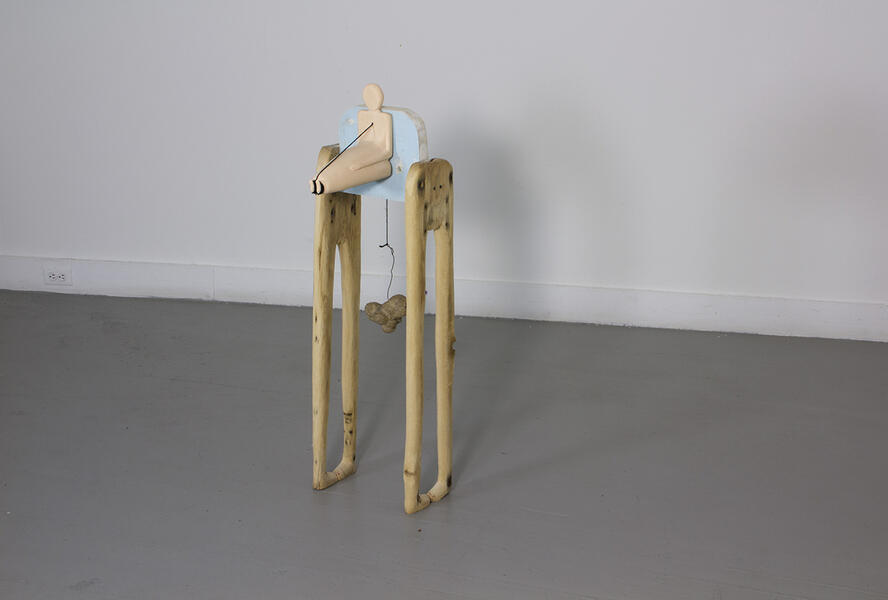 You lacked the artist's usual skillsYou lacked the artist's usual skills: fossil, found wood, yarn, ren board, 14 x 13 x 44 in. Yarn wraps around the carved figure's feet and pierces it's chest. Fossilized poop is attached to the end of the yarn and functions as a counter weight to the carved figure.
You lacked the artist's usual skillsYou lacked the artist's usual skills: fossil, found wood, yarn, ren board, 14 x 13 x 44 in. Yarn wraps around the carved figure's feet and pierces it's chest. Fossilized poop is attached to the end of the yarn and functions as a counter weight to the carved figure. -
 Strange loop
Strange loop











